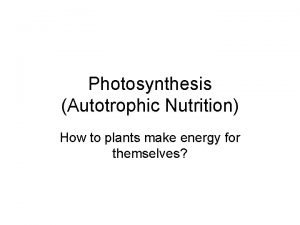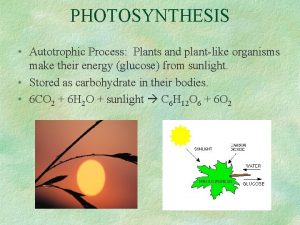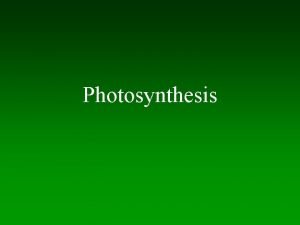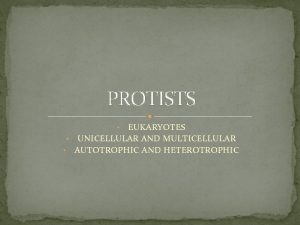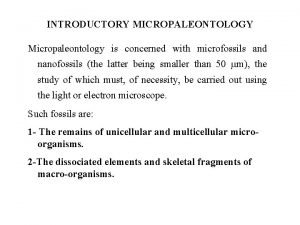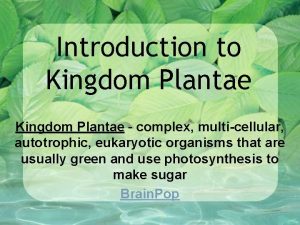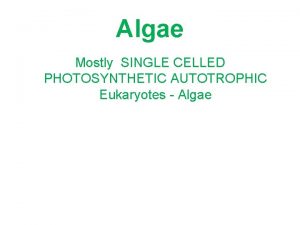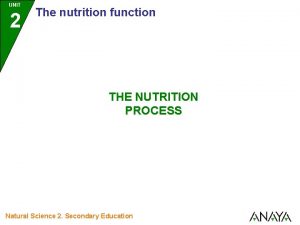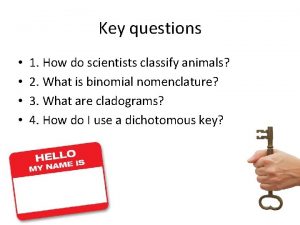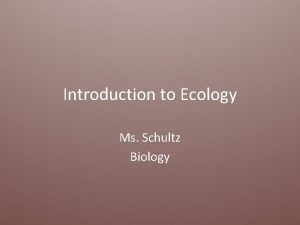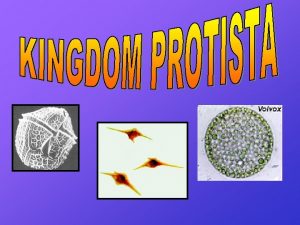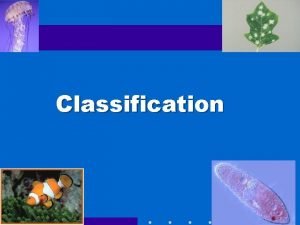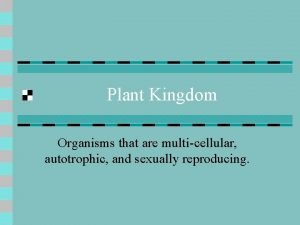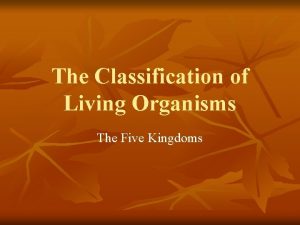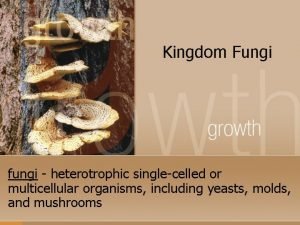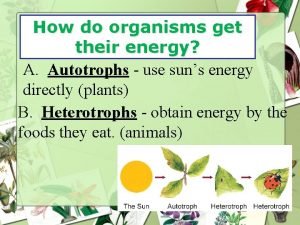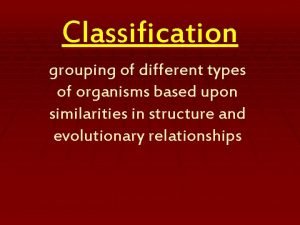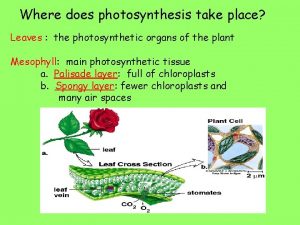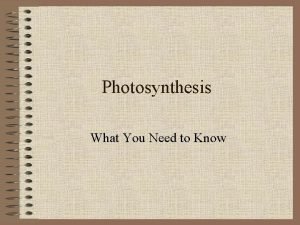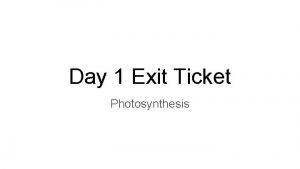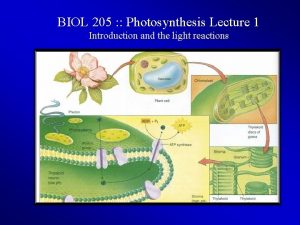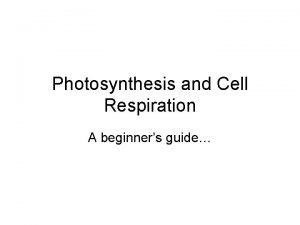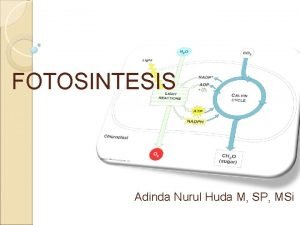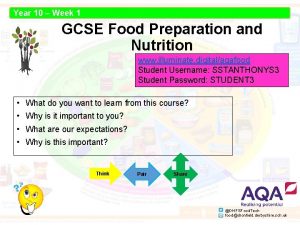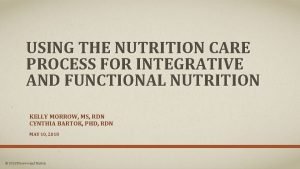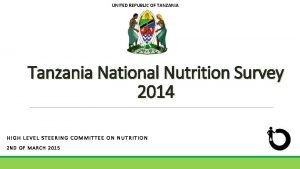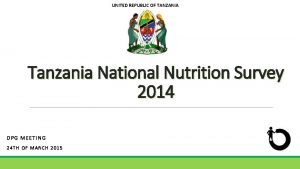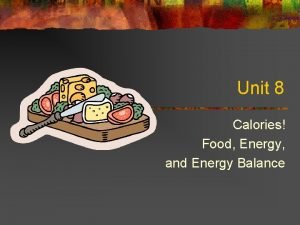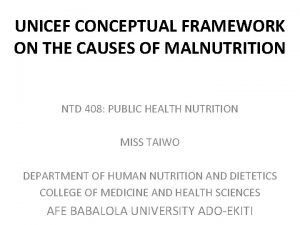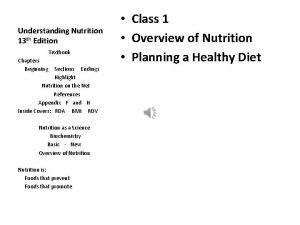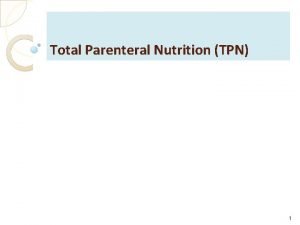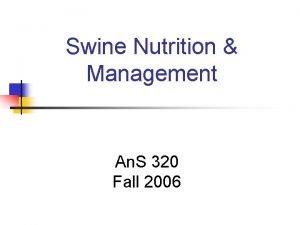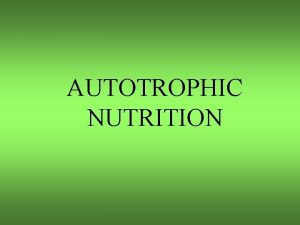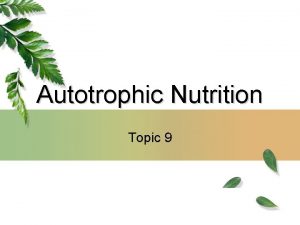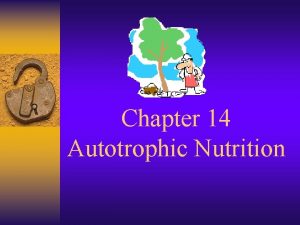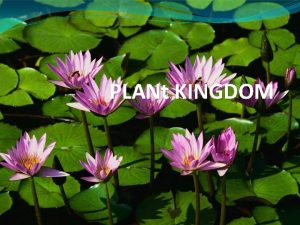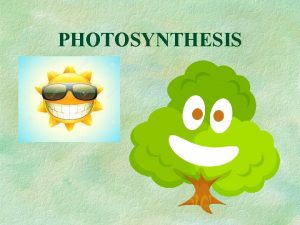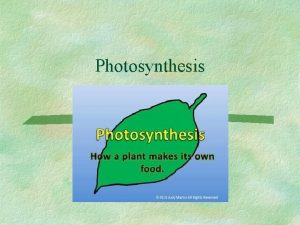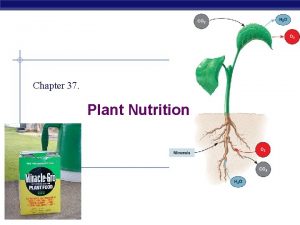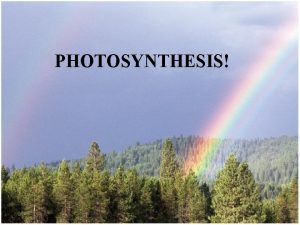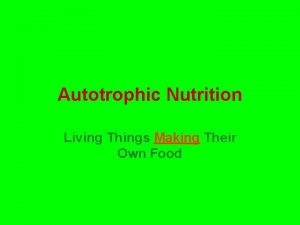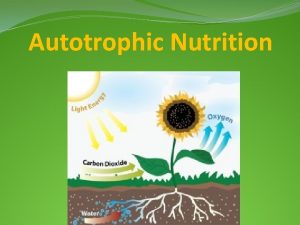PHOTOSYNTHESIS or Autotrophic Nutrition PHOTOSYNTHESIS PHOTOSYNTHESIS What does





































- Slides: 37

PHOTOSYNTHESIS or Autotrophic Nutrition

PHOTOSYNTHESIS

PHOTOSYNTHESIS § What does a plant need to survive? § _________________ § Which of the above is organic? ______

PHOTOSYNTHESIS § Photosynthesis is the process by which plants convert inorganic molecules into organic molecules. § Photosynthesis is the process by which plants convert light energy into chemical bond energy. § Photosynthesis is the process by which plants convert sunlight into glucose.

PHOTOSYNTHESIS § Chloroplasts are the site of photosynthesis

PHOTOSYNTHESIS § Electron Micrograph of a chloroplast

PHOTOSYNTHESIS

PHOTOSYNTHESIS § Formula for photosynthesis:

The leaf



PHOTOSYNTHESIS

PHOTOSYNTHESIS § Occurs in two phases: § Light Phase § Occurs in the GRANA in the chloroplasts § Dark Phase § Occurs in the STROMA in the chloroplasts

Light Phase/Reaction § Occurs only in the presence of light § Also called Photolysis § Sunlight splits water into hydrogen and oxygen § Also called Light Dependent Reaction

Light Phase/Reaction § Drawing of Photolysis:

Dark Phase/Reaction § In order for the DARK PHASE to occur, HYDROGEN has to be carried from the LIGHT PHASE to the DARK PHASE. § This carrier molecule is called NADP. § When NADP is carrying hydrogen, it is NADPH.

Dark Phase/Reaction § § § Also called Light Independent Reaction Also called Carbon Fixation. In this phase, CARBON DIOXIDE from the atmosphere combines with HYDROGEN from the light reaction to form GLUCOSE. § ATP is diffused from the grana into the stroma for the dark reaction.

Carbon Fixation § Formula and drawing of Dark Reaction: § CO 2 + H 2 2 PGAL glucose

Factors Effecting Photosynthesis § § Temperature Light Intensity Availability of Water Elevation

Graphs for Photosynthesis

CELLULAR RESPIRATION § Occurs in plants AND animals. § Occurs in the MITOCHONDRIA and CYTOPLASM.

CELLULAR RESPIRATION § The process by which energy in food molecules (glucose) is converted to a form that can be used by the cells (ATP). § Can be AEROBIC (uses O 2) or ANAEROBIC (does NOT use O 2)

CELL RESPIRATION § Picture

CELLULAR RESPIRATION § ATP § Adenosine Tri-Phosphate = ENERGY § Comes from chemical bonds breaking § The more bonds broken, the more energy made. § Energy is stored in high energy phosphate bonds.

CELLULAR RESPIRATION

ANAEROBIC RESPIRATION § § § Occurs in the CYTOPLASM Makes energy WITHOUT using oxygen. Glucose is partially broken down. Also called GLYCOLYSIS or FERMENTATION. Produces: § Ethyl Alcohol ( in yeast) § Lactic Acid (in bacteria or human muscle cells).

ANAEROBIC RESPIRATION § Pyruvic Acid § produced by the breakdown of sugars during GLYCOLYSIS

ANAEROBIC RESPIRATION § Formula

AEROBIC RESPIRATION § § § Making ATP USING oxygen. Occurs in the MITOCHONDRIA More energy efficient than anaerobic respiration (releases more energy). § Bonds in glucose are completely broken down.

AEROBIC RESPIRATION § Formula: C 6 H 12 O 6 + 2 ATP Pyruvate CO 2 + H 2 O + 38 ATP O 2

Steps of Aerobic Respiration 1. Glycolysis (Anaerobic Respiration) • Makes pyruvic acid, which is then broken down • Produces 4 ATP (gross)

Steps of Aerobic Respiration 2. Kreb’s Cycle (Citric Acid Cycle) • Produces citric acid, which is then broken down • Bonds in the sugar are completely broken down, releasing CO 2

Steps of Aerobic Respiration 3. Electron Transport Chain • Oxygen is the final hydrogen acceptor so glucose bonds can be FULLY broken down. • Releases H 2 O

AEROBIC RESPIRATION

CELLULAR RESPIRATION Lactic acid

CELLULAR RESPIRATION & PHOTOSYNTHESIS

CELLULAR RESPIRATION & PHOTOSYNTHESIS
 Stomata opening
Stomata opening What are the byproducts of autotrophic nutrition
What are the byproducts of autotrophic nutrition Autotrophic nutrition requires
Autotrophic nutrition requires Eukaryotic, unicellular, and autotrophic
Eukaryotic, unicellular, and autotrophic Are protists unicellular or multicellular
Are protists unicellular or multicellular Are fungi heterotrophic or autotrophic
Are fungi heterotrophic or autotrophic Micropaleontology lecture notes
Micropaleontology lecture notes Which kingdom is autotrophic
Which kingdom is autotrophic Are spirogyra autotrophic or heterotrophic
Are spirogyra autotrophic or heterotrophic Process of nutrients
Process of nutrients Are rotifers autotrophic or heterotrophic
Are rotifers autotrophic or heterotrophic Community picture biology
Community picture biology Paramecium heterotrophic or autotrophic
Paramecium heterotrophic or autotrophic Autotrophic plants examples with names
Autotrophic plants examples with names A multicellular autotrophic organism with vascular tissue
A multicellular autotrophic organism with vascular tissue What are the characteristic of bacteria
What are the characteristic of bacteria Is protoctista autotrophic or heterotrophic
Is protoctista autotrophic or heterotrophic Plantae characteristics
Plantae characteristics Yeasts are single celled heterotrophs
Yeasts are single celled heterotrophs A multicellular autotrophic organism with vascular tissue
A multicellular autotrophic organism with vascular tissue Is euglena autotrophic or heterotrophic
Is euglena autotrophic or heterotrophic Where does photosynthesis take place
Where does photosynthesis take place What raw materials does a plant need for photosynthesis
What raw materials does a plant need for photosynthesis How does photosynthesis happen
How does photosynthesis happen What organelle does photosynthesis take place *
What organelle does photosynthesis take place * How does photosynthesis take place?
How does photosynthesis take place? Photosynthesis equation
Photosynthesis equation Where does photosynthesis take place? *
Where does photosynthesis take place? * Gcse food tech high skill dishes
Gcse food tech high skill dishes Nutrition care process
Nutrition care process Tanzania national nutrition survey 2020
Tanzania national nutrition survey 2020 Tanzania national nutrition survey 2020
Tanzania national nutrition survey 2020 Biobeyond unit 8 counting calories
Biobeyond unit 8 counting calories Conceptual framework on the causes of malnutrition
Conceptual framework on the causes of malnutrition Understanding nutrition 13th edition rental
Understanding nutrition 13th edition rental Rxkinetics tpn
Rxkinetics tpn Swine nutrition management
Swine nutrition management Specialized nutritional support
Specialized nutritional support
